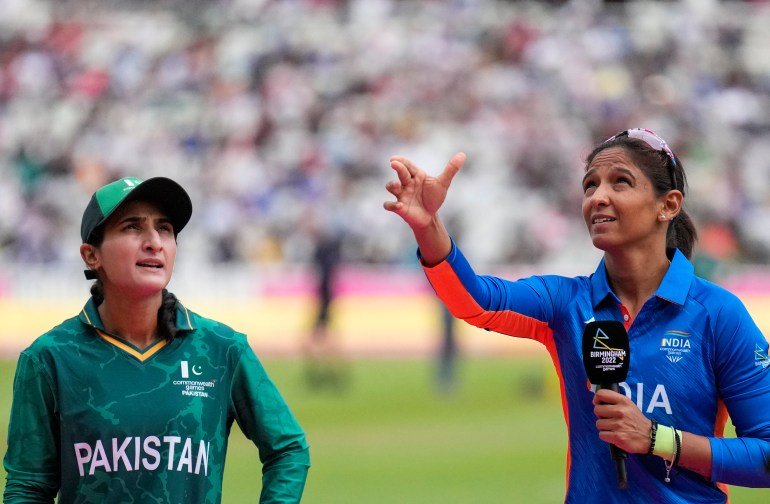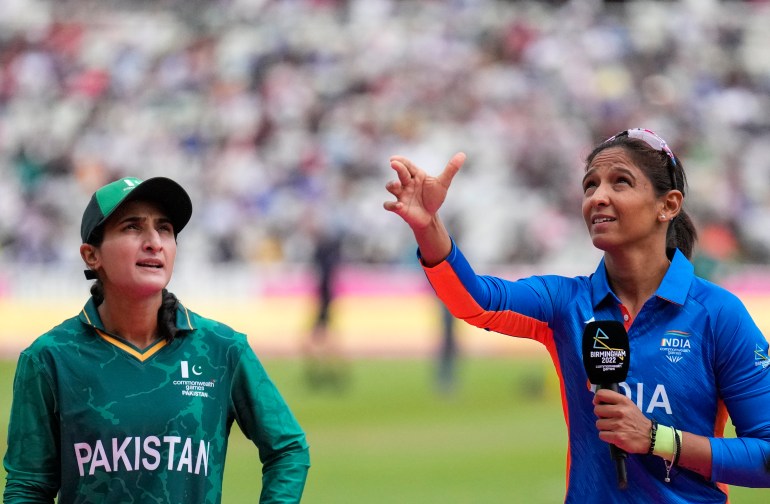
Former Pakistan cricket captain Bismah Maroof remembers the look of befuddlement that quieted the typically beaming face of her two and a half year old daughter, Fatima, as she bid a tearful goodbye to her national teammates in Karachi on Thursday.
“She had never seen us like this,” Maroof, 32, told Al Jazeera, hours after calling time on her 17-year international career.
“Neither my teammates nor I could hold back; it was an emotional farewell as I exited the Pakistan squad and left for my hometown, Lahore. Fatima, naturally, couldn’t make sense of any of it.”
Maroof’s decision to quit international cricket came as a surprise, not least because of the timing – a day before the opening fixture of Pakistan’s home T20 international series in Karachi against the West Indies. She was part of the 16-player squad for the assignment.
“It wasn’t a sudden decision, to be honest,” Maroof, Pakistan’s leading run-scorer in women’s ODIs and T20Is, said. “I had long pondered my international retirement, and given the T20 World Cup is just four months away, it only felt fair that I walked away before the T20I series against West Indies.
“I wasn’t sure if I could sustain myself until the World Cup, so it was best I made way for the players who deserve a proper run in the lead-up to the World Cup.
‘The time was right for my Pakistan teammates and family’
“At this phase of my life,” said Maroof, who captained Pakistan in 96 matches – 62 in T20Is and 34 in ODIs, “I felt my family should take precedence, so I discussed the matter with them and gauged it as objectively as I could.
“Walking away from a team I had been part of since I first walked into it as a 15-year-old was never going to be easy. But the time was right, for the sake of my Pakistan teammates and my family.”
Pakistan Zindabad! 🇵🇰 pic.twitter.com/6otSXiXnnI
— Bismah Maroof (@maroof_bismah) April 25, 2024
For someone who had become a regular companion of Maroof’s on pretty much every tour of hers since her inspirational return to professional cricket in March 2022 after childbirth, it was fitting that her daughter witnessed her final moments in the Pakistan dressing room as an international cricketer.
The social media graphic carrying Maroof’s retirement announcement unsurprisingly, too, had an image of her walking away holding her daughter’s hand.
The symbolism attached to Fatima in Maroof’s career is key to understanding the athlete’s imprint on her sport, especially in the subcontinent context.
Her legacy, after all, will be defined not only by her captaincy accomplishments, or her record 6,262 runs across 276 limited-over international appearances but also by her decision to return to top-flight cricket in March 2022, no less as captain, just six months after the birth of her first child, Fatima.
“After embracing motherhood, never did I see Bismah fall short of balancing her professional and non-professional roles,” Maroof’s close friend and longtime Pakistan teammate Javeria Khan, who retired from international cricket last month, told Al Jazeera.
“With her mother, Nighat, by her side, they both created an example out of Bismah – that a Pakistani woman can play top-level cricket after giving birth.
“She is a true icon and inspiration for so many. Pakistan cricket was really blessed to have a player like Bismah.”
A silent contributor ♥️
Aunty, words fall short to describe your contribution.
You helped in Bismah’s dream to persue cricket after the arrival of Fatima. I dont think so she would have done without you. Mothers like you help their daughters to scale huge mountains.
The… pic.twitter.com/LCks0Ahibv
— Javeria Khan (@ImJaveria) April 25, 2024
‘Setting an example for women across the globe’
Female cricketers playing sport at the highest level after marriage, let alone childbirth, is a rarity in this part of the world. In that sense, Maroof has been an outlier.
Her pregnancy had nudged the Pakistan Cricket Board (PCB) into formalising a paid maternity leave policy for the first time, and of which Maroof became the first beneficiary.
When she came out of her maternity leave, to lead Pakistan in the 2022 ODI World Cup in New Zealand, leading voices in the sport, including her contemporaries, hailed her as a groundbreaker. “…setting an example for women across the globe,” wrote star India batter Smriti Mandhana on her Instagram story with a viral picture of Fatima cradled in Maroof’s arms, surrounded by the India players, after the India vs Pakistan fixture in the world tournament.
“When I think of my return post-childbirth two years ago, I still can’t help but wonder, ‘Arre, maine yeh kaise kar liya? (How did I manage to pull it off?),’” Maroof said, smiling.
“It wasn’t easy because for nearly two years Fatima had to be breastfed. Balancing motherly duties with my playing commitments was a challenge – physically and emotionally. Without that policy or the support of my mother, father and husband, I wouldn’t have been able to play this long.”
Under the PCB policy, Pakistan’s centrally contracted cricketers are entitled to up to 12 months of paid maternity leave and are guaranteed a contract extension for the following year alongside several other benefits on either side of childbirth.
While no Pakistani cricketer has subsequently availed of the policy, Maroof has maintained that the PCB’s handling of her pregnancy could serve as a case study for other cricket-playing nations, particularly in South Asia.
“I remember when I took the pregnancy leave, I was overcome with a sense of guilt of not having done enough for Pakistan cricket, but the maternity policy fortified my desire and resolve to make a comeback,” said Maroof. “I thought: ‘If the board was doing that much for me, I had to do my best to return to Pakistan side.’
“I had a good deal of cricket left in me and I wanted to share my experiences with my other teammates, especially the younger ones.”

Looking back, Maroof describes that decision as one of the most “formative” ones, not just in her career, but also in her life. “It’s not common in our South Asian culture for women to enter motherhood, play professional sport and carry one’s child around with oneself on sporting assignments. Because of its rarity, I knew my motherhood would be covered by global media, so it was imperative to try to be at my competitive best for my country and also highlight the role of everyone, including my teammates, who made the journey possible.”
A stylish left-hand batter who bowled part-time leg-spin, Maroof witnessed women’s cricket both in its nascency and its current professional embodiment in Pakistan. Having debuted against India in 2006, she went on to represent her country at the 2009, 2013, 2017, and 2022 ODI World Cups and featured in all eight editions of the T20 World Cup to date – from 2009 to 2023.
In June 2016, she took over the T20I captaincy from the legendary Sana Mir and then the ODI reins in September 2017.
“When I started playing cricket, very few people knew that Pakistan had a women’s cricket team. Even I had no clue about women’s cricket,” Maroof said. “But things have changed over time. In Pakistani society, there’s greater acceptance of girls playing cricket now. In fact, I have seen parents encouraging their daughters to take up cricket. Social media has also played a huge part in taking women’s cricket to places it had no presence in.”
A trailblazing tale for Pakistan women’s cricket
Sana Mir, who Maroof replaced, wrote on her X social media account in response to the retirement announcement: “Sad to see you go before the ICC T20 World Cup in Bangladesh later in the year. May your decision bring you peace.
“You have been a wonderful Ambassador and a rock for Pakistan batting lineup.”
Under Maroof’s captaincy, Pakistan defeated the higher-ranked New Zealand for the first time in ODIs, in 2017. The most-capped Pakistan woman in the format, she counts that victory among her career highlights, alongside the two gold-medal triumphs in the 2009 and 2010 Asian Games.
“For me, the discipline that cricket has taught me through the ups and downs in my career and those faced by women’s cricket in Pakistan has one of my biggest takeaways from my 17 years wearing the national jersey,” Maroof said.
“It’s built my core and identity.”
Beyond playing league cricket, Maroof said she hasn’t invested much thought yet in what her life might look like after her international retirement. As a self-avowed woman of few words, she believes she’s not cut out for commentary, but promises to keep a close eye on how the women’s game in Pakistan progresses hereon.
“The struggles my generation of female cricketers, or those before us like Sana experienced, are no longer there,” she said. “But there’s pressure of expectations on the younger lot. And to meet those expectations, our domestic structure needs strengthening and align it with the standard of international cricket.
“I hope to see Pakistan among the top four international teams because there’s no dearth of talent in our country.”
A smidgen of support might be all that is needed, as is borne out by Maroof’s trailblazing tale.
EMEA Tribune is not involved in this news article, it is taken from our partners and or from the News Agencies. Copyright and Credit go to the News Agencies, email [email protected] Follow our WhatsApp verified Channel









